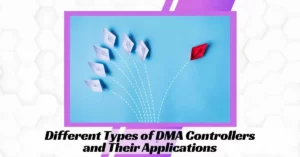Table of Contents
ToggleIntroduction
A DMA controller is a hardware device that is used to transfer data between devices without involving the CPU. It is a specialized microcontroller that acts as a mediator between the device and the memory, allowing for data to be moved quickly and efficiently.
When a device such as a hard disk or network interface wants to transfer data to or from memory, it typically has to send a request to the CPU. The CPU then reads or writes the data to memory, which can be a time-consuming process, especially when dealing with large amounts of data. This is where the direct memory access controller comes in. Instead of going through the CPU, the device sends its data request directly to the direct memory access controller.
The direct memory access controller then takes control of the bus and begins transferring data between the device and memory. The CPU is only involved in setting up the DMA-controller and receiving an interrupt when the transfer is complete. This allows the CPU to perform other tasks while the data transfer is taking place, improving overall system performance.
The direct memory access (dma) controller operates by using DMA channels, which are specific paths for data transfer between the device and memory. These channels are programmed by the CPU with the necessary parameters, such as the source and destination addresses, and the transfer size. Once programmed, the direct memory access controller takes over and performs the data transfer autonomously.
Overall, the direct memory access controller provides a faster and more efficient way of transferring data between devices and memory, reducing the load on the CPU and improving system performance.
The Advantages of Using a DMA Controller in Your System

Using a DMA (Direct Memory Access) controller in your system can bring several advantages, including increased system performance, reduced CPU utilization, and improved data transfer efficiency.
Firstly, direct memory access controller can significantly improve system performance by offloading the CPU from data transfer tasks. The CPU can be free to perform other tasks while the DMA-controller takes care of data transfers between devices and memory. This results in faster data transfer rates and increased overall system performance.
Secondly, direct memory access controller can reduce CPU utilization, freeing up processing power for other tasks. Since the CPU is not involved in every data transfer, it can focus on other tasks, improving the overall efficiency of the system.
Another advantage of using a direct memory access controller is improved data transfer efficiency. Data transfer between devices and memory is streamlined, and the DMA-controller ensures that the data transfer is error-free. It also supports burst transfers, where multiple data transfers occur in a single operation, reducing the overall transfer time.
DMA-controllers are particularly useful in systems that handle large amounts of data, such as video and audio streaming applications. In such applications, the direct memory access controller can ensure that data is transferred smoothly and efficiently, without causing any lag or interruptions.
In summary, using a direct memory access controller in your system can bring several advantages, including improved performance, reduced CPU utilization, and improved data transfer efficiency. It is an essential component in modern systems that handle large amounts of data and can help optimize system performance.
Click here to know more about: data science course in kerala
Different Types of DMA Controllers and Their Applications

There are several types of DMA (Direct Memory Access) controllers, each designed for specific applications. The following are some of the most common types of DMA-controllers and their applications:
Single DMA-Controller: This type of direct memory access controller is used in systems where there is only one device that needs to transfer data to or from memory.
Dual DMA-Controller: A dual DMA-controller is used in systems where there are two devices that need to transfer data to or from memory simultaneously.
Cascaded DMA-Controller: A cascaded direct memory access controller is used in systems where there are more than two devices that need to transfer data to or from memory simultaneously. The cascaded direct memory access controllerconnects multiple controllers in a chain to enable the transfer of data from multiple devices.
Scatter-Gather DMA-Controller: This type of Direct Memory Access controller is used in systems where data needs to be transferred to or from multiple non-contiguous memory locations. The Scatter-Gather DMA controller can transfer data from multiple sources to multiple destinations simultaneously.
Cycle Stealing DMA-Controller: This type of DMA is used in systems where the CPU and the DMA share the same bus. The Cycle Stealing DMA will temporarily halt the CPU and take control of the bus to perform data transfers.
Overall, the type of DMA used in a system depends on the specific requirements of the application. Different direct memory access controller can be used to optimize data transfer performance, minimize CPU utilization, and ensure the smooth transfer of data between devices and memory.
Common Design Considerations When Using a DMA Controller
When using a DMA (Direct Memory Access) controller, there are several design considerations that must be taken into account to ensure the efficient and safe operation of the system. Some of the common design considerations are as follows:
DMA Channel Configuration: DMA channels need to be configured correctly, including the source and destination addresses, transfer size, and transfer mode.
Priority: Different DMA channels may have different priority levels. It is important to consider which channels have higher priority when designing the system to ensure that the system operates efficiently.
Synchronization: Synchronization between the CPU and the direct memory access controller is essential to prevent conflicts between the two. The DMA-controller should have appropriate synchronization mechanisms to ensure that it does not interfere with the CPU’s operation.
Interrupt Handling: The direct memory access controller generates interrupts when a data transfer is complete. Proper interrupt handling is crucial to ensure that the system operates efficiently and that the data transfer is complete and accurate.
Bus Access: DMA-controllers require bus access to transfer data between devices and memory. It is important to ensure that the DMA-controller has appropriate bus access and does not interfere with other devices on the bus.
Error Handling: DMA-controllers should have appropriate error handling mechanisms to detect and handle errors that may occur during data transfer. This ensures the integrity of the data and prevents system crashes.
In summary, when using a DMA-controller, designers need to carefully consider several design factors, including DMA channel configuration, priority, synchronization, interrupt handling, bus access, and error handling. By taking
these design considerations into account, designers can ensure the efficient and safe operation of the system.
Also read about: data analytics courses in Mumbai
How to Program a DMA Controller for Your System

Programming a DMA (Direct Memory Access) controller for your system involves several steps. Here are the general steps involved:
Initialization: The first step is to initialize the Direct Memory Access controller. This includes setting up the DMA channel configuration, such as the source and destination addresses, transfer size, and transfer mode.
Enable the DMA Channel: Once the Direct Memory Access controller is initialized, the DMA channel needs to be enabled to start the data transfer.
Synchronization: Synchronization is crucial to prevent conflicts between the CPU and the DMA-controller. The controller should have appropriate synchronization mechanisms to ensure that it does not interfere with the CPU’s operation.
Interrupt Handling: The Direct Memory Access controller generates interrupts when a data transfer is complete. Proper interrupt handling is crucial to ensure that the system operates efficiently and that the data transfer is complete and accurate.
Error Handling: Direct Memory Access controller should have appropriate error handling mechanisms to detect and handle errors that may occur during data transfer. This ensures the integrity of the data and prevents system crashes.
Disabling the DMA Channel: Once the data transfer is complete, the DMA channel should be disabled to release the system resources.
Programming a direct memory access controller requires knowledge of the direct memory access controller’s programming interface and the system architecture. Several programming languages and development tools are available to program a DMA, such as C/C++, assembly language, and direct memory access controller-specific APIs.
In summary, programming a DMA-controller for your system involves initializing the direct memory access controller, enabling the DMA channel, synchronizing the Direct Memory Access controller, handling interrupts and errors, and disabling the DMA channel once the data transfer is complete. It requires knowledge of the DMA-controller’s programming interface and the system architecture.
Troubleshooting DMA Controller Issues

When troubleshooting DMA (Direct Memory Access) controller issues, there are several tips and techniques that can be useful in identifying and resolving the issues. Here are some tips and techniques:
Check the DMA Configuration: One of the most common issues with controllers is incorrect DMA channel configuration. It is important to check the DMA configuration, including the source and destination addresses, transfer size, and transfer mode.
Verify Bus Access: Direct Memory Access controller require bus access to transfer data between devices and memory. Check if the DMA controller has appropriate bus access and does not interfere with other devices on the bus.
Check for Interrupts: DMA generate interrupts when a data transfer is complete. If the data transfer is not complete, or if the Direct Memory Access controller is not generating interrupts, it may indicate an issue with the Direct Memory Access controller.
Verify Synchronization: Synchronization between the CPU and the controller is essential to prevent conflicts between the two. Check if the Direct Memory Access controller has appropriate synchronization mechanisms to ensure that it does not interfere with the CPU’s operation.
Check for Error Handling: DMA controllers should have appropriate error handling mechanisms to detect and handle errors that may occur during data transfer. Check if the DMA controller is detecting and handling errors properly.
Use Debugging Tools: Debugging tools such as oscilloscopes and logic analyzers can be useful in identifying Direct Memory Access controller issues. These tools can help visualize the data transfer and identify any anomalies.
In summary, troubleshooting Direct Memory Access controller issues requires careful attention to the DMA configuration, bus access, interrupts, synchronization, error handling, and the use of appropriate debugging tools. By following these tips and techniques, designers can identify and resolve DMA controller issues efficiently and ensure the efficient and safe operation of the system.
Real-World Examples of DMA Controller Implementation
DMA (Direct Memory Access) controllers are widely used in various real-world applications. Here are some examples of DMA-controller implementation:
Networking: DMA-controllers are used in networking devices such as routers and switches to transfer data between the network interface and memory. The DMA-controller is used to offload the CPU from the data transfer task and improve the overall performance of the system.
Storage: DMA-controllers are used in storage devices such as hard drives and solid-state drives to transfer data between the storage device and memory. The DMA-controller is used to improve the efficiency of data transfer and reduce CPU overhead.
Audio and Video: DMA-controllers are used in audio and video devices such as digital signal processors and graphics cards to transfer data between the device and memory. The DMA controller is used to reduce latency and improve the overall performance of the system.
Embedded Systems: direct memory access controller are commonly used in embedded systems to transfer data between devices and memory. The DMA is used to reduce the load on the CPU and improve the system’s real-time performance.
Medical Devices: DMA-controllers are used in medical devices such as ultrasound machines to transfer data between the device and memory. The Direct Memory Access controller is used to improve the device’s performance and reduce the risk of errors in medical imaging.
In summary, Direct Memory Access controller are used in various real-world applications to transfer data between devices and memory. They are commonly used in networking, storage, audio and video, embedded systems, and medical devices. The Direct Memory Access controller implementation improves the performance of the system, reduces CPU overhead, and improves the system’s real-time performance.
DMA Controller vs. Interrupts: Which is Better for Your System?
Both DMA (Direct Memory Access) controllers and interrupts have their advantages and disadvantages, and the choice of which to use depends on the system’s specific requirements. Here are some considerations when deciding between direct memory access controller and interrupts:
DMA controllers:
Advantages: Direct Memory Access controller are useful when transferring large amounts of data between devices and memory, as they can offload the CPU and reduce its overhead. They can also improve the system’s overall performance by allowing the CPU to perform other tasks while the data transfer occurs.
Disadvantages: DMA-controllers can be more complex to implement than interrupts and may require additional hardware. They may also require synchronization mechanisms to prevent conflicts with the CPU.
Interrupts:
Advantages: Interrupts are useful when a quick response is required, as they allow the CPU to respond to an event immediately. They are also easier to implement than DMA controllers and do not require additional hardware.
Disad
vantages: Interrupts can be less efficient than direct memory access controller when transferring large amounts of data, as they require the CPU to perform the data transfer task, which can increase its overhead.
In summary, DMA-controllers are better suited for transferring large amounts of data and offloading the CPU, while interrupts are better suited for quick responses. The choice of which to use depends on the system’s specific requirements and the trade-offs between efficiency and response time.
Limitations of DMA Controllers and How to Overcome Them
While DMA (Direct Memory Access) controllers offer significant advantages for transferring data between devices and memory, they also have some limitations. Here are some limitations of DMA controllers and how to overcome them:
Limited address space: DMA-controllers have a limited address space, which can limit the amount of data that can be transferred at once. This can be overcome by using a scatter-gather DMA, which allows the controller to access multiple memory regions for a single data transfer.
Limited bandwidth: DMA-controllers have a limited bandwidth, which can limit the rate of data transfer. This can be overcome by using multiple direct memory access controller in parallel, or by increasing the clock speed of the DMA controller.
Limited buffer size: direct memory access controller have a limited buffer size, which can limit the size of data that can be transferred at once. This can be overcome by using a circular buffer, which allows the controller to continuously transfer data between the device and memory without running out of buffer space.
Compatibility issues: DMA-controllers may not be compatible with all devices and may require specific drivers or hardware. This can be overcome by selecting compatible devices and hardware, or by using software emulation to simulate the direct memory access controller.
Data corruption: DMA controllers may be susceptible to data corruption if there are conflicts between the CPU and DMA-controller accessing the same memory region. This can be overcome by using synchronization mechanisms such as locks or semaphores to prevent conflicts.
In summary, DMA controllers have limitations, such as limited address space, bandwidth, and buffer size, as well as compatibility issues and potential data corruption. These limitations can be overcome by using techniques such as scatter-gather DMA, parallel DMA-controllers, circular buffers, selecting compatible devices and hardware, software emulation, and synchronization mechanisms.
Future Developments and Trends in DMA Controller Technology
DMA (Direct Memory Access) controllers have been a key technology for improving system performance and reducing CPU overhead in data transfer operations. As technology continues to advance, here are some possible future developments and trends in DMA controller technology:
Increased bandwidth: With the growing demand for higher data transfer rates, DMA may see improvements in their bandwidth capabilities. This could be achieved through increasing clock speeds or by adopting newer technologies such as PCIe Gen 5 or Gen 6.
Integration with AI: With the increasing demand for AI applications, direct memory access controller may see integration with AI hardware such as GPUs or TPUs. This could enable more efficient data transfer between the CPU and AI hardware, improving system performance and reducing latency.
Improved security: DMA controllers may see improvements in security features to prevent unauthorized access or tampering of data during transfer. This could be achieved through hardware-level encryption or other security mechanisms.
Increased automation: With the growing popularity of automation and characteristics of IoT, direct memory access controller may see improvements in their ability to operate autonomously. This could enable more efficient data transfer operations without human intervention.
Integration with other technologies: DMA-controllers may see integration with other emerging technologies such as 5G, edge computing, or blockchain. This could enable more efficient and secure data transfer operations in these areas.
In summary, future developments and trends in direct memory access controller technology may focus on increasing bandwidth, integrating with AI, improving security, increasing automation, and integrating with other emerging technologies. These developments could significantly improve system performance and enable new applications and use cases for DMA controllers.
Conclusion
In conclusion, DMA (Direct Memory Access) controllers are an essential technology that has greatly improved system performance and reduced CPU overhead in data transfer operations. DMA-controllers allow devices to directly access the memory without involving the CPU, which results in faster and more efficient data transfer.
DMA-controllers come in different types, each with specific applications and design considerations. Common design considerations when using direct memory access controller include memory mapping, buffer allocation, and synchronization mechanisms to prevent data corruption.
Whiledirect memory access controller offer significant advantages, they also have some limitations, such as limited address space, bandwidth, and buffer size, as well as compatibility issues and potential data corruption. However, these limitations can be overcome by using techniques such as scatter-gather DMA, parallel DMA-controllers, circular buffers, selecting compatible devices and hardware, software emulation, and synchronization mechanisms.
As technology continues to advance, direct memory access controller may see improvements in their bandwidth capabilities, integration with AI and other technologies, improved security features, increased automation, and more. These developments could significantly improve system performance and enable new applications and use cases for DMA controllers.
Overall, Direct Memory Access controller have been and will continue to be a key technology for improving system performance and reducing CPU overhead in data transfer operations.
Frequently Asked Questions
What is a DMA controller?
A DMA (Direct Memory Access) controller is a hardware device that allows devices to directly access the memory without involving the CPU. This results in faster and more efficient data transfer.
What are the advantages of using a DMA controller?
DMA controllers offer several advantages, such as reducing CPU overhead, increasing system performance, and enabling data transfer between different devices at high speeds. They also free up the CPU to perform other tasks while data transfer is taking place.
What are the different types of DMA controllers?
The different types of DMA controllers include single-channel DMA, multi-channel DMA, cascaded DMA, demand-paged DMA, and cycle-stealing DMA. Each type has specific applications and design considerations.
How do you program a DMA controller?
Programming a DMA controller involves setting up the DMA registers, allocating memory for the transfer buffer, and configuring the device-specific registers. This can be done using DMA controller-specific libraries or by directly accessing the DMA registers in the system.
What are the common issues when using a DMA controller?
Common issues when using a DMA controller include memory mapping, buffer allocation, synchronization mechanisms to prevent data corruption, and compatibility issues between devices and hardware. These issues can be overcome using techniques such as scatter-gather DMA, circular buffers, selecting compatible devices and hardware, and synchronization mechanisms.













